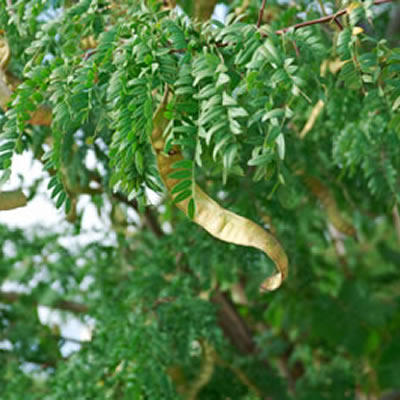
Carob Gum
Also Known as Locust Bean Gum, LBG, or carubin
What is Carob Gum?
Carob gum is a very versatile hydrocolloid and natural dietary fiber that is extensively used as a thickening and gelling agent in dairy and bakery products, sauces, fruit fillings, soups, processed cheese, and many other processed foods. It helps provide:
- Texture
- Viscosity
- Gelling
- Fiber
Origin
Locust bean gum is a natural polysaccharide extracted from the endosperm of the seeds of the carob tree Ceratonia siliqua found in Southern Europe and Northern Africa.1 It is a large polymer with a molecular weight of about 350,000 Da and consists of a linear chain backbone of β-D-1,4-linked mannose units. Some mannose units within the mannan backbone are attached to D-galactose units linked via α-(1→6) bonds.
Carob gum, LBG, is similar in structure to guar gum, differing primarily in that locust bean gum has a lower galactose to mannose ratio (approx. 1:4).1,2
Function
Carob bean gum has a neutral taste, good texture, and improves the viscosity of many food systems.
LBG provides the following functionality and benefits:
- Creamy texture in ice creams
- Good syneresis control
- Water binder (control of bake loss)
- High viscosity in low doses (valuable in batter-based sweet goods)
- Gelling power upon cooling (when hydrated and heated, and in synergy with other hydrocolloids)
- Dietary fiber source to enhance nutritional value of bakery formulas
Hydrocolloid effects:
- LBG + Water at room temperature → Thickening effect
- LBG + Water + Heat → Gelling effect (74°C / 165°F)
- LBG + Xanthan gum + Water a room temperature → Gelling effect
- LBG + Carrageenan + Water a room temperature → Gelling effect
Commercial production
Once the carob fruits are harvested, they are dried and roasted. Next, the seeds are separated from the meat of the fruit. The seeds are skinned and then gently ground and sifted. This is to separate the germ from the endosperm, which is then sent through roller mills to create carob gum. Carob gum is then sold either as a white or brown powder.
Application
Carob bean gum is unique in its ability to partially swell in cold water though requiring heating to approximately 82°C (179 oF) for complete solubility. Typical usage level is 0.1–1.0%.
Performance of carob gum compared to other gums 3,1
| Carrageenan | Alginate | Cellulose gum | Guar gum | Microcrystalline cellulose | Pectin | Xanthan gum | LBG (carob) | |
|---|---|---|---|---|---|---|---|---|
| Cold soluble/ Dispersible | + | +++ | +++ | +++ | +++ | ++ | ++ | + |
| Gelling with calcium | ++ | ++ | – | – | – | +++ | ||
| Thinning at high temperature | ++ | +++ | + | +++ | + | +++ | +++ | +++ |
| Heat stable gel | – | +++ | – | – | ++ | ++ | – | – |
| Low pH limit | 3.8 | 3.8 | 4.0 | 3.5 | 3.5 | 2.0 | 2.0 | 3.5 |
| High pH limit | > 8.0 | < 8.0 | > 8.0 | > 8.0 | > 8.0 | < 5.5 | > 8.0 | > 8.0 |
General considerations when using carob gum:
- The need for a somewhat intense mixing to be fully hydrated and incorporated into water solutions. Manual stirring or whisking may cause lumping so a blender or high-shear mechanical mixer is the best way of incorporating LBG into liquid products (e.g. batters, viscous suspensions).
- Effective dispersion in cold water and further heating to 80°C (176°F) for 10 minutes to fully hydrate the polysaccharide. Carob gum molecules have a high hydrodynamic volume and can entangle with adjacent molecules (e.g. proteins), resulting in unique viscoelastic properties.
- Synergistic interactions with xanthan gum and carrageenans result in gel formation.
- As with other natural gums and fibers, solubility of LBG in water varies with molecular weight. Generally, carob gum is soluble in water, sucrose solutions and sodium chloride solution. Solubility declines with increasing molecular weight and increasing concentration. Dispersibility of the gum is also pH-independent; making it useful in bakery applications since most baked good systems are within the 4 to 8 pH range.3
Regulation
Carob gum holds GRAS status in the US and is now included in the list of dietary fibers listed on nutrient labels.4 It is also permitted for food applications in Europe and has the E-number (E410).
References
- Msagati, T.A.M. “Stabilisers, Gums, Thickeners and Gelling Agents as Food Additives.” Chemistry of Food Additives and Preservatives, John Wiley & Sons, Ltd., 2013, pp. 67–82.
- Wielinga, W. “Seed Gums.” Food Stabilisers, Thickeners and Gelling Agents, Blackwell Publishing Ltd, 2010, pp. 275–291.
- Nieto, M.B., and Akins, M. “Hydrocolloids in Bakery Fillings.” Hydrocolloids in Food Processing, Blackwell Publishing, Ltd., 2011, pp. 67–107.
- Federal Register: Electronic Code of Federal Regulations, Title 21, Chapter I, Subchapter B, PART 182 – SUBSTANCES GENERALLY RECOGNIZED AS SAFE, https://ecfr.federalregister.gov/current/title-21/chapter-I/subchapter-B/part-182, Accessed 12 October 2020.

